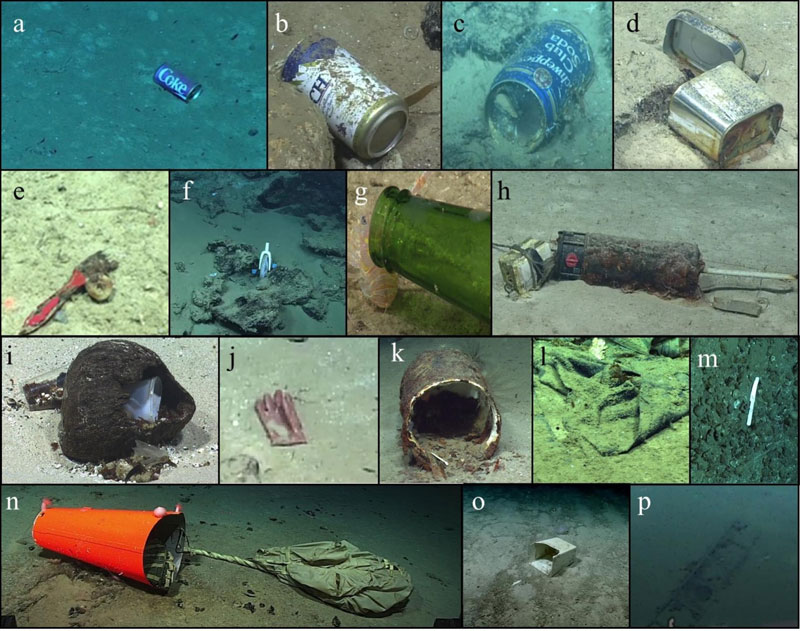Expeditions Identify Widespread Debris in Deep Tropical Atlantic and Caribbean Sea
Evidence of marine debris pollution in the deep sea has continued to mount as expeditions explore more regions of the ocean. New imagery collected during expeditions led by NOAA Ocean Exploration and partners adds to these findings by revealing widespread plastic, metal, and glass debris in deep waters of the tropical Atlantic and Caribbean sea. These discoveries, presented in a paper recently published in the Marine Pollution Bulletin, highlight the need to account for deep, remote regions of the ocean as destinations for pollution.

Researchers exploring deep waters of the tropical Atlantic and Caribbean found many pieces of marine debris between 2015 and 2022. Source: Fuller et al. 2024, Observations of trash in the deep tropical Atlantic and Caribbean Sea . Download largest version (jpg, 1.12 MB)
Pollution in shallow and coastal waters is often easy to notice, but debris that sinks to the deep ocean can be just as important to consider. The deep ocean makes up the largest habitat on Earth, containing a stunning variety of life that can be affected by pollution and other human activities. Deep-ocean environments are also linked to life in the shallows, meaning that environmental problems there may have negative consequences nearer to the surface.
The massive size of the deep ocean makes the scale of the pollution within it hard to study, so every expedition is an important chance to learn more about deep-ocean trash. The latest research on the subject presented in the journal relies on images and video collected between 2015 and 2022 by teams on three separate research vessels: NOAA Ship Okeanos Explorer, NOAA Ship Nancy Foster, and Woods Hole Oceanographic Institution (WHOI) Research Vessel Atlantis. Much of the trash was spotted using remotely operated vehicles (ROVs) deployed from the vessels to dive deep below the surface. Other debris was identified using human-occupied deep submergence vehicle Alvin, which the WHOI team used to explore the Puerto Rico Trench while verifying science operations on the newly overhauled submersible for its new depth limit of 6,500 meters (4 miles).
Researchers studied the images and video collected on these expeditions to the tropical Atlantic and Caribbean, reviewing footage from years of work to identify the trash. Many of the researchers were students: the newly published results feature 10 undergraduate student and recent graduate co-authors, a figure that was made possible by both open access NOAA Ocean Exploration dive recordings and a grant from the National Marine Sanctuary Foundation and NOAA Ocean Exploration to support inclusion and expand research opportunities in ocean science. In all, the researchers observed 139 separate pieces of marine litter. Aluminum cans, glass bottles, clothing, a ladder, and various kinds of plastic were identified between 250 and 6,000+ meters (820 and 19,685 feet) below the surface.
Deep-ocean animals were seen interacting with the debris in many ways: fish swam in and out of plastic bottles, while seafloor animals like anemones were found attached to larger pieces of trash. While no direct harm to animals was observed in the present study, marine debris is often dangerous to wildlife . Plastic debris can also break down into microplastics, which may then be eaten by animals and spread health consequences to other organisms throughout the food web.
These observations of marine debris in the deep ocean reinforce our growing understanding that pollution isn’t just a concern in the shallows. Evidence is mounting that deepwater regions are a common destination for trash, even in remote areas with little or no regular human presence. The findings shared in this research will have to be taken into account when considering important issues related to pollution and sustainability.
This new study was led by Nikki Fuller of the State University of New York (SUNY) at Geneseo. It was co-authored by Emily McMahon, Allison North, A.J. Petty, Chryssanthi Tzetzis, Jacob Calus, Abisage Sekarore, Gabriel Rosado, Erin Patton, Julia Cappiello, and Mackenzie E. Gerringer (also from SUNY Geneseo) as well as Andrea M. Quattrini (Smithsonian National Museum of Natural History), Kasey Cantwell, Thomas Morrow, and Samuel Candio (NOAA Ocean Exploration), Daniel Wagner (Ocean Exploration Trust), Brian Kennedy (Ocean Discovery League), Adam Soule (University of Rhode Island), and Anna P.M. Michael (Woods Hole Oceanographic Institution).
Fuller et al. (2024) Observations of trash in the deep tropical Atlantic and Caribbean Sea. Marine Pollution Bulletin 209A. Access the full article online
Published November 14, 2024